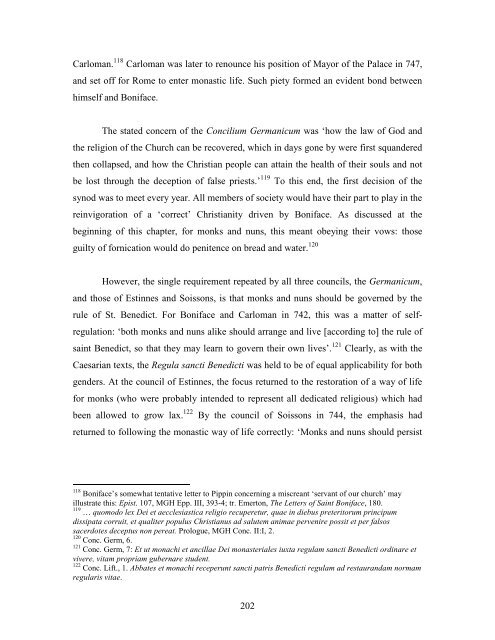Lindsay Rudge PhD Thesis - University of St Andrews
Lindsay Rudge PhD Thesis - University of St Andrews
Lindsay Rudge PhD Thesis - University of St Andrews
You also want an ePaper? Increase the reach of your titles
YUMPU automatically turns print PDFs into web optimized ePapers that Google loves.
Carloman. 118 Carloman was later to renounce his position <strong>of</strong> Mayor <strong>of</strong> the Palace in 747,<br />
and set <strong>of</strong>f for Rome to enter monastic life. Such piety formed an evident bond between<br />
himself and Boniface.<br />
The stated concern <strong>of</strong> the Concilium Germanicum was ‘how the law <strong>of</strong> God and<br />
the religion <strong>of</strong> the Church can be recovered, which in days gone by were first squandered<br />
then collapsed, and how the Christian people can attain the health <strong>of</strong> their souls and not<br />
be lost through the deception <strong>of</strong> false priests.’ 119 To this end, the first decision <strong>of</strong> the<br />
synod was to meet every year. All members <strong>of</strong> society would have their part to play in the<br />
reinvigoration <strong>of</strong> a ‘correct’ Christianity driven by Boniface. As discussed at the<br />
beginning <strong>of</strong> this chapter, for monks and nuns, this meant obeying their vows: those<br />
guilty <strong>of</strong> fornication would do penitence on bread and water. 120<br />
However, the single requirement repeated by all three councils, the Germanicum,<br />
and those <strong>of</strong> Estinnes and Soissons, is that monks and nuns should be governed by the<br />
rule <strong>of</strong> <strong>St</strong>. Benedict. For Boniface and Carloman in 742, this was a matter <strong>of</strong> self-<br />
regulation: ‘both monks and nuns alike should arrange and live [according to] the rule <strong>of</strong><br />
saint Benedict, so that they may learn to govern their own lives’. 121 Clearly, as with the<br />
Caesarian texts, the Regula sancti Benedicti was held to be <strong>of</strong> equal applicability for both<br />
genders. At the council <strong>of</strong> Estinnes, the focus returned to the restoration <strong>of</strong> a way <strong>of</strong> life<br />
for monks (who were probably intended to represent all dedicated religious) which had<br />
been allowed to grow lax. 122 By the council <strong>of</strong> Soissons in 744, the emphasis had<br />
returned to following the monastic way <strong>of</strong> life correctly: ‘Monks and nuns should persist<br />
118<br />
Boniface’s somewhat tentative letter to Pippin concerning a miscreant ‘servant <strong>of</strong> our church’ may<br />
illustrate this: Epist. 107, MGH Epp. III, 393-4; tr. Emerton, The Letters <strong>of</strong> Saint Boniface, 180.<br />
119<br />
… quomodo lex Dei et aecclesiastica religio recuperetur, quae in diebus preteritorum principum<br />
dissipata corruit, et qualiter populus Christianus ad salutem animae pervenire possit et per falsos<br />
sacerdotes deceptus non pereat. Prologue, MGH Conc. II:I, 2.<br />
120<br />
Conc. Germ, 6.<br />
121<br />
Conc. Germ, 7: Et ut monachi et ancillae Dei monasteriales iuxta regulam sancti Benedicti ordinare et<br />
vivere, vitam propriam gubernare student.<br />
122<br />
Conc. Lift., 1. Abbates et monachi receperunt sancti patris Benedicti regulam ad restaurandam normam<br />
regularis vitae.<br />
202

















